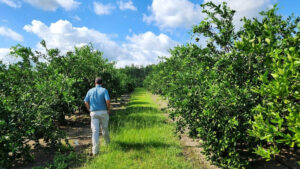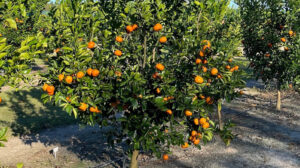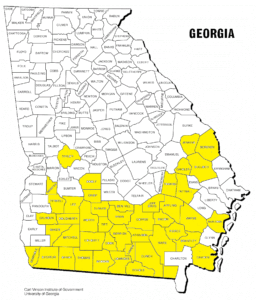This story was originally published by Grist. Sign up for Grist’s weekly newsletter here. This coverage is made possible through a partnership with WABE and Grist, a nonprofit, independent media organization dedicated to telling stories of climate solutions and a just future.
By Emily Jones, Grist
On a punishingly hot August morning, Jake Price walked through his rows of citrus trees, tucked in the back corner of a field behind an elementary school. They looked like an image right out of a commercial for Florida orange juice: lush, leafy trees, many of them laden with plump fruit.

Only this wasn’t in Florida, it was in Georgia.
Price is an extension agent for the University of Georgia in Lowndes County, and his trees are in Valdosta, about half an hour from the Florida border. He’s growing several kinds of small citrus fruit, including a type of mandarin known as a tango, one of the easy-to-peel varieties that’s easy to throw in a kid’s school lunch.
“Look how much fruit this tree has,” Price said, approaching one of the tango trees. “There’s probably 25 pounds per tree on these.”
Citrus is a new crop for Georgia, one that’s taking root thanks to the combined forces of climate change, crop science and disease in Florida. Although that citrus powerhouse is just to the south, historically it’s been just enough colder in Georgia to discourage farmers from growing citrus. Freezing was considered too big a risk, a threat that could take out the fruit just as it’s ripening.
But a new citrus industry in Georgia is growing rapidly. There were very few citrus trees in the state a decade ago. Now, there are more than 500,000 trees across nearly 4,000 acres.
The burgeoning industry faced its biggest test yet last winter. Around Christmas, citrus trees in southern Georgia had to weather six days below freezing. Many of their leaves shriveled up and died. By January, the frigid air had killed limbs and split huge wounds into trunks and branches, weakening them permanently. Farmers worried the freeze could hurt their new crop.
But Price isn’t a farmer. He’s a scientist, so the cold snap became an experiment.
Most citrus trees are hybrids: a delicious fruit like tangos grafted onto the roots of a variety with other desirable traits, like a manageable size or resistance to pests and diseases. Price is conducting a study to find out which rootstocks weathered the freeze well and which took a lot of damage or are struggling to bounce back.

“It’s kind of a rare opportunity to get some data on which rootstocks give the best cold protection on these tangos, so I’m gonna get it while the getting’s good,” Price said.
Farmers will be able to use his findings to ensure they’re planting trees that can weather Georgia winters, which aren’t as cold as they used to be.
“I just remember being cold a lot,” Price said of his childhood in the 1970s. “You would be cold in October. But now, October, we’re still in the 90s sometimes.”
Climate change is heating up winters especially fast. The average winter temperature in Albany, Georgia, has risen 6.5 degrees Fahrenheit since 1970, according to Climate Central. That means fewer sustained freezes, so Georgia is increasingly fertile ground for citrus.
Farmer Justin Jones decided to take advantage of these changes when he was looking to diversify his crops. He was growing the Georgia staples of pecans and cotton at his farm near Albany, in southwest Georgia, but wanted to add something new to the mix.
“It goes back to the old adage, just don’t put all your eggs in one basket,” he said. “Spread out your risk a little bit.”
Farming always involves risk from the weather, diseases, insects and all kinds of other factors that can affect crop yields. And climate change is throwing new curveballs at growers.
Peaches — the state’s iconic fruit, though far from its largest crop — need a certain amount of chill hours in winter to produce fruit, so the same winter warming that’s helping citrus is hurting peaches. And in 2018, Hurricane Michael, which rapidly gained strength as it approached the Florida Panhandle thanks to warmer water temperatures, cut a wide swath of devastation across southwest Georgia farms, hurting that year’s crop and doing long-term damage to peach and pecan trees.
This year, Georgia peaches are in crisis. An unusually warm January and February coaxed peach trees to bloom early. A typical seasonal freeze in March then devastated the blossoms. The federal government declared a natural disaster in 18 Georgia counties following the freeze, to help farmers cope. Similar dynamics have also slammed Georgia blueberries in the past few years, even though blueberries are usually one of the top 10 crops in the state.
In his bid to spread out his risks by diversifying, Jones found citrus appealing because it has the potential to make good money: Each tree can bear a lot of fruit, so farmers can get a lot of revenue out of each acre. Because the industry is so new in Georgia, he was also able to open a packing house — an additional revenue stream. Jones now grows satsumas and navel oranges.
“We have a piece of fruit that looks like it’s grown in California, but tastes like it’s grown in Florida, which is what everybody wants,” he said.

Georgia growers like Jones are also taking advantage of an opening in the citrus market created by disease. Citrus greening, caused by bacteria spread by a bug known as the Asian citrus psyllid, has devastated Florida’s citrus industry since it first arrived in 2005. As of 2022, the state had less than half the citrus acres it did in the 1990s.
“Unfortunately, in the farming community, in the farming world, somebody has to do bad for somebody to do good,” said Jones.
Growers in Georgia are taking steps to keep out the disease that’s decimated Florida’s citrus, and Senator Jon Ossoff, a Georgia Democrat, is now pushing for the state to have a seat on a national panel on citrus disease.
“We have to be conscious of what we’re doing here in Georgia, in order to protect not only our industry, but our sister state industry,” said Lindy Savelle, president of the Georgia Citrus Association.
Despite the disease and the recent growth of Georgia citrus, Florida still has about 100 times the citrus acreage Georgia does. And the nascent industry is an even smaller fraction of Georgia’s overall agricultural output, which boasts more than a million acres of cotton, over 600,000 acres of peanuts and about 20,000 acres of blueberries, compared to just 4,000 acres of citrus.
Still, the industry is gaining steam. This year, the state legislature established a citrus commodity commission, a signal it’s becoming a big enough crop to need research and marketing.
Last winter’s sustained freeze will likely hurt this year’s citrus crop, as trees that took heavy damage expend their energy regrowing limbs and leaves instead of producing fruit. But because citrus ripens in late fall and winter, Price and other experts said the trees have time to recover and regrow — unlike the peach trees that had their delicate blooms destroyed by the later freeze in March.
Now that Georgia’s small citrus growers have shown they can survive a bad winter, Savelle said, bigger farms are getting interested.
“The confidence level of our growers is continuing to go up,” she said. “They realize, ‘Well, my gosh, if I can handle 17, 15 degrees for four days, that’s a 30-year weather event. I think I can do this.’”
Even though the freeze may hurt this year’s crop, Savelle said it was also a big test — and Georgia citrus passed.
This article originally appeared in Grist at https://grist.org/agriculture/climate-change-now-brings-you-citrus-from-the-peach-state/.
Grist is a nonprofit, independent media organization dedicated to telling stories of climate solutions and a just future. Learn more at Grist.org.
Sign up for The Invading Sea newsletter by visiting here. If you are interested in submitting an opinion piece to The Invading Sea, email Editor Nathan Crabbe at ncrabbe@fau.edu.



